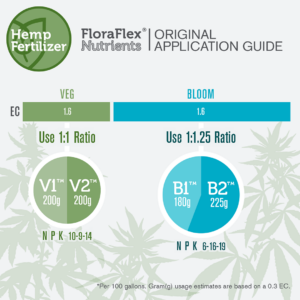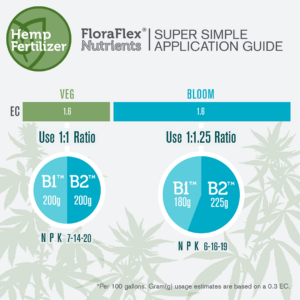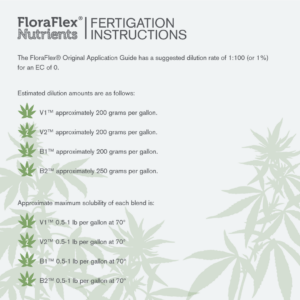Coupled with horticulturalists boasting decades of experience in cannabis nutrition and FloraFlex’s drive to make the best products we have developed a simple two-part formula for both the Vegetative and Bloom stages that is engineered to entice early flower site development, maximized yields and the highest potency your genetics will allow.
WHY #HEMPFERTILIZER
PRODUCT OFFERING
14 - 0 - 4
V1™ is the first half of a 2-two part water soluble formula, providing essential nutrients needed for vigorous plant growth throughout the entire vegetative stage.
Vegetative Part 1
14-0-4
6 - 17 - 25
V2™ is the second half of a 2-two part water soluble formula, providing essential nutrients needed for vigorous plant growth throughout the entire vegetative stage.
Vegetative Part 2
6-17-25
6 - 17 - 25
B1™ is the first half of a 2-two part water soluble formula, providing essential nutrients needed for vigorous plant growth throughout the entire flowering stage.
Bloom Part 1
14-0-22
0 - 28 - 18
B2™ is the second half of a 2-two part water soluble formula, providing essential nutrients needed for vigorous plant growth throughout the entire flowering stage.
Bloom Part 2
0-28-18
INSTRUCTIONS & APPLICATIONS
Because of the scale of these operations, the preference is typically to have a simple and consistent two part regimen, with the right nutrient formula that already includes all of the essential elements for healthy plant growth. Click on an image to download as a PDF.
USAGE CALCULATOR
.
ESSENTIAL ELEMENTS
Plants need an array of elements to reach their full nutritional potential. Three of these elements—carbon, hydrogen and oxygen—are taken in through the air and water. The remaining have to come through the plant’s roots.
Below are the essential elements and what they do for your favorite plant. They’re divided into three categories: macronutrients, secondary nutrients and micronutrients. All of these Essential Elements are included in the FloraFlex® Nutrients. We designed it as a simple two part formula for both the Vegetative and Bloom cycles to give you the ability to improvise and control the process with the knowledge of essential element benefits.
Macronutrients
Nitrogen (N) is the main nutrient for strong vigorous growth, good leaf color, and photosynthesis. In the first half of a plant’s life it takes in 80% of the nitrogen it needs for the entirety of its growth cycle. Plants absorb nitrogen through their roots in a nitrate form, so for our purposes growth rates can be easily manipulated by how much nitrogen we feed our plants. (In our blends Nitrogen is stored in art 1 of both V & B.If you ever feel like you are having a nitrogen deficiency,simply increase V1/B1 or decrease V2/B2 in your formula in order to get to your desired EC or PPM).
Phosphorous (P) is key to photosynthesis, allowing plants to transform energy from sun/lights and other chemicals into food for the plant. It’s also important for plant respiration, their energy storage and transfer, and impacts the structure of a plant through cell division and cell growth. Ultimately, plants that are lacking Phosphorus will display stunted growth and their yields will suffer. In the early stages of growth Phosphorus strengthens your plants through healthy root development. Once in Bloom it helps promote flower sites, increases size, and assists with the ripening of your plants flowers, fruits, or buds. (You will find Phosphorous exclusively in Part 2: V2/B2 of our blends which enables you to easily increase or decrease the amount of Phosphorus in your formula as you see fit.)
Potassium (K) improves the overall health of plants and is responsible for producing higher quality flowers, fruits, or buds. It helps stimulate early growth in your plants, fruit formation, photosynthesis, and the uptake of other nutrients, which increases protein, resists insects and diseases, and aides in the protection of your plants against extreme temperatures. (We provide plenty of the Potassium needed for your plants to thrive in V2, B1, and B2. There is less Potassium in V1).
Not Included and Why
Nickel (Ni) has been identified as an essential element in only a few fruit crops and our favorite plant isn’t one of them.
Chlorine (CI) is required in very small quantities and there is usually enough in the water supply. Chloride toxicity is a more common problem and this is the reason chloride is usually not included in most feed programs including ours.
Secondary Nutrients
Secondary Nutrients are no less essential than Macronutrients, and are only called “secondary” because most plants need them in smaller quantities.
Calcium (Ca) is important for overall plant strength and promotes vigorous growth of young roots and shoots. It helps build cell walls, allows for cell elongation and cell division, is involved in nitrogen metabolism, reduces plant respiration, stimulates microbial activity, and aids the translocation of photosynthesis form leaves to flowers, fruits, and buds. (Necessary amounts will be found in V1 and B1).
Magnesium (Mg) is a component of chlorophyll like phosphorous, so is also necessary for photosynthesis. It helps improve the utilization and mobility of phosphorus, is an activator and component of many plant enzymes, and impacts the early uniformity of your plants. (Necessary amounts will be found in V2 and B2).
Sulfur (S) significantly assists with the formation of chlorophyll. It helps maintain a dark green shade and encourages vigorous plant growth. It also helps produce proteins, enzymes, amino acids and vitamins, and assists in disease resistance. (Necessary amounts will be found in V2 and B2)
Micronutrients
“Micro” sounds even less important than “secondary,” yet even though your plants require only trace amounts of Micronutrients, they cannot live without them. We have made sure that you have the required amounts of these elements for your plants, while simultaneously ensuring that they stay well under the heavy metal requirements set by certain states.
Boron (B) contributes to cell wall strength, helps in cell development and division, is necessary for sugar transport and hormone development, and is essential in key growth parts of plants such as root tips and new leaf buds.
Copper (Cu) helps metabolize nitrogen, the formation of chlorophyll, promotes growth through enzyme activity, increases sugar content, intensifies color, and improves flavor.
Iron (Fe) acts as an oxygen carrier, promotes formation of chlorophyll, and helps with respiration and photosynthesis.
Manganese (Mn) aids in chlorophyll synthesis by activating fat forming enzymes, increases availability of (P) and (CA), and helps in electron transport during photosynthesis.
Molybdenum (Mo) converts nitrates into amino acids within plants and converts inorganic phosphorus into an organic form. Simply put: it helps plants use Nitrogen.
Zinc (Zn) aids in the development of enzymes and hormones, is necessary for chlorophyll production, promotes carbohydrate and starch formation, and helps with the maturation time of plants.







